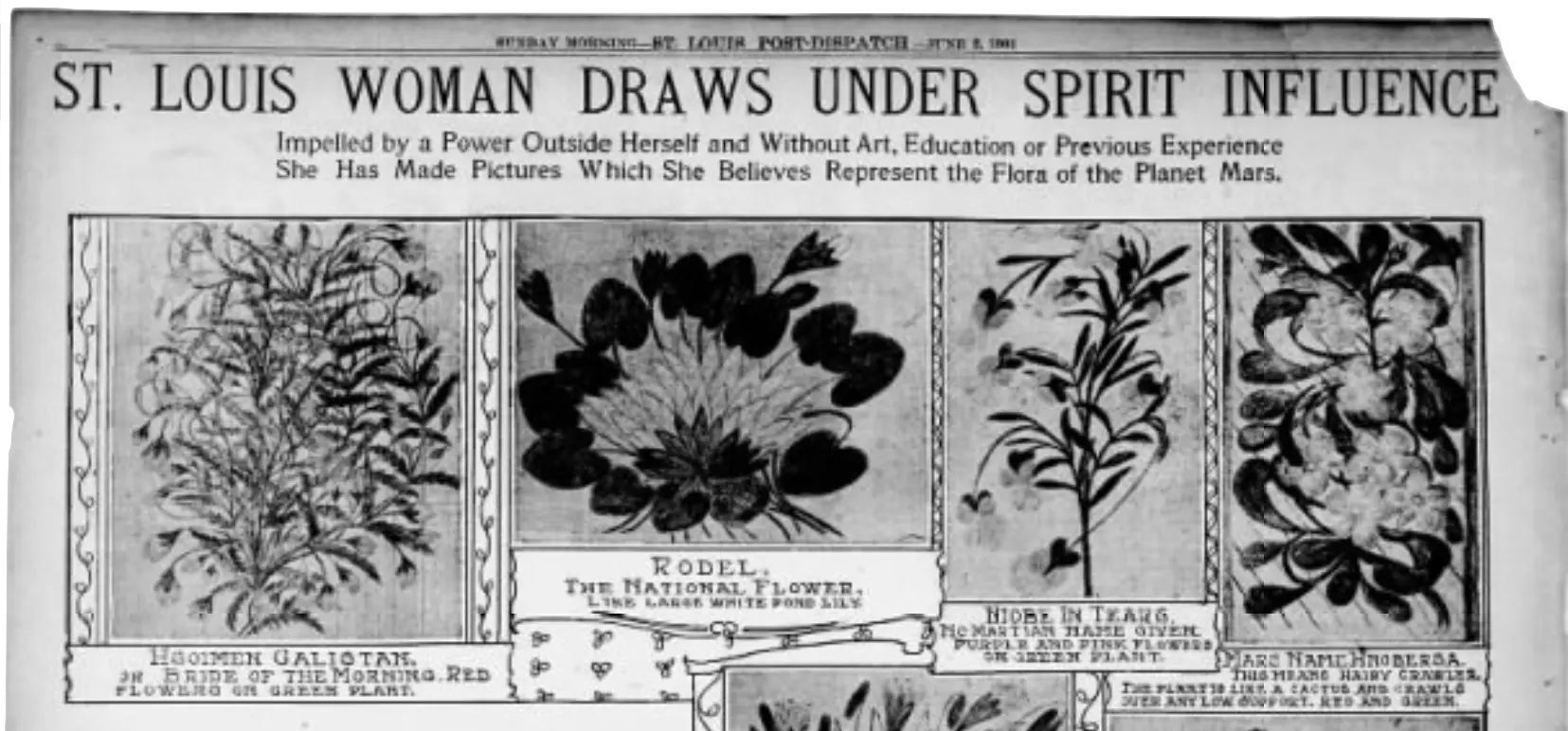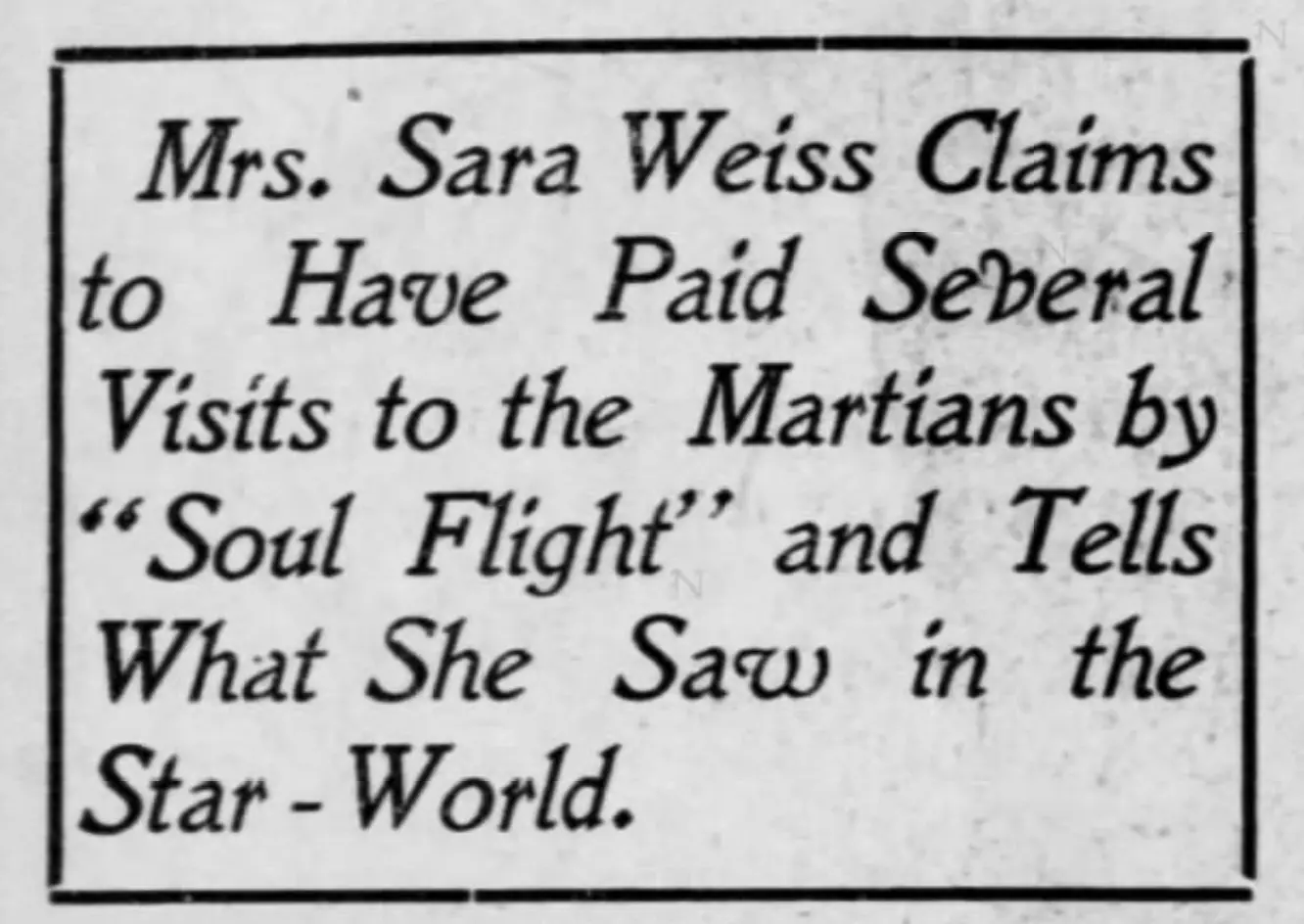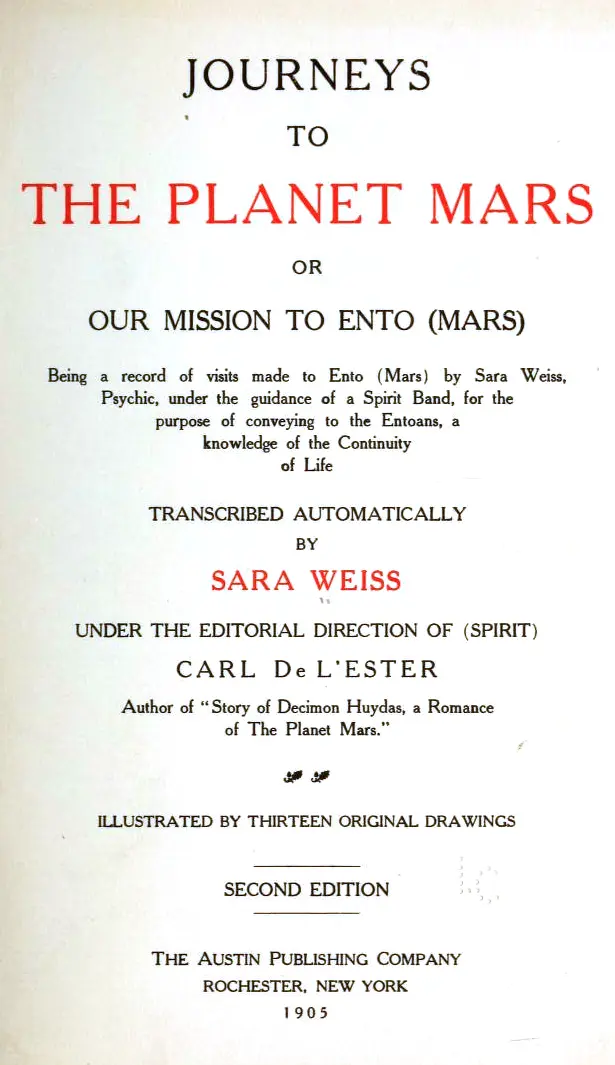Journeys to the Planet Mars (1903)
Sara Weiss
Complete subtitle: “Being a record of visits made to Ento (Mars) by Sara Weiss, Psychic, under the guidance of a Spirit Band, for the purpose of conveying to the Entonans, a knowledge of the Continuity of Life”
This puzzle of a book, “transcribed automatically” by St. Louis resident Sara Weiss (b. 1834), was written sometime in her 60s and published just before her death in 1904. She and her family always maintained that the book was entirely dictated to her by “Carl De L’Ester (Spirit)” and other deceased individuals. It contains thirteen illustrations of Martian plants drawn by Weiss, purportedly through the psychic direction of an illustrator, and sprinkled with words and phrases in Entoan, the language of Mars. The first edition was likely published by private subscription, but The Austin Publishing Company, a short-lived Spirtualist publisher founded by Benjamin Fish Austin, produced a second edition and its posthumous sequel of sorts, Decimon Hûŷdas.
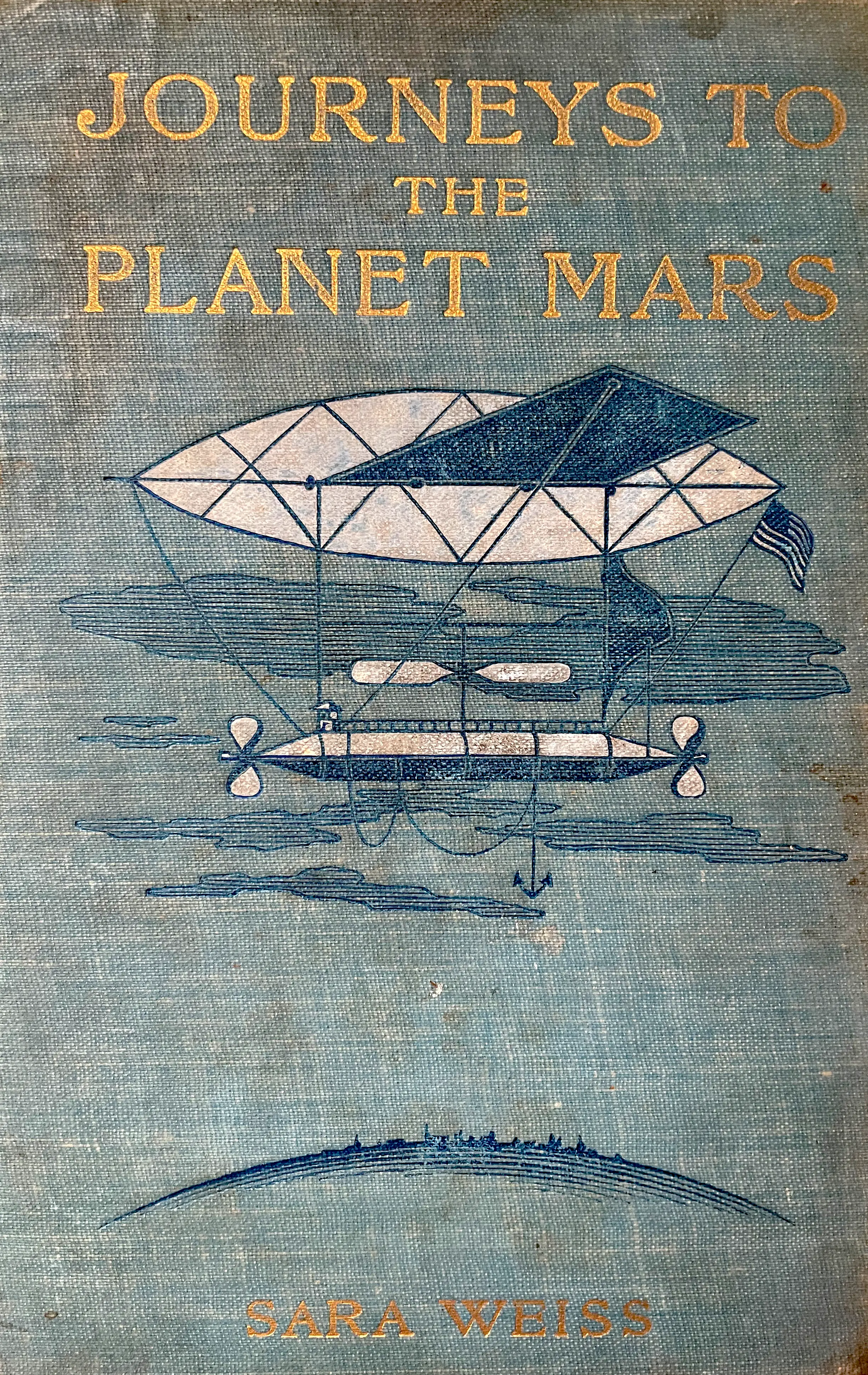
Plot
“Onos isson ē twa̤, ēmanos.” (Hail, hail; we welcome you, friends.)
In each chapter, “Sara Weiss” is psychically transported to Mars by one of her spirit guides. The guides are largely fictional but are enthusiastic name-droppers, passing along commentary about Martian biology and culture from notables like Charles Darwin and Edward Bulwer-Lytton. Her journeys are said to have occurred—precisely!—between October 6, 1892 and September 16, 1894, during a period of convalescence.
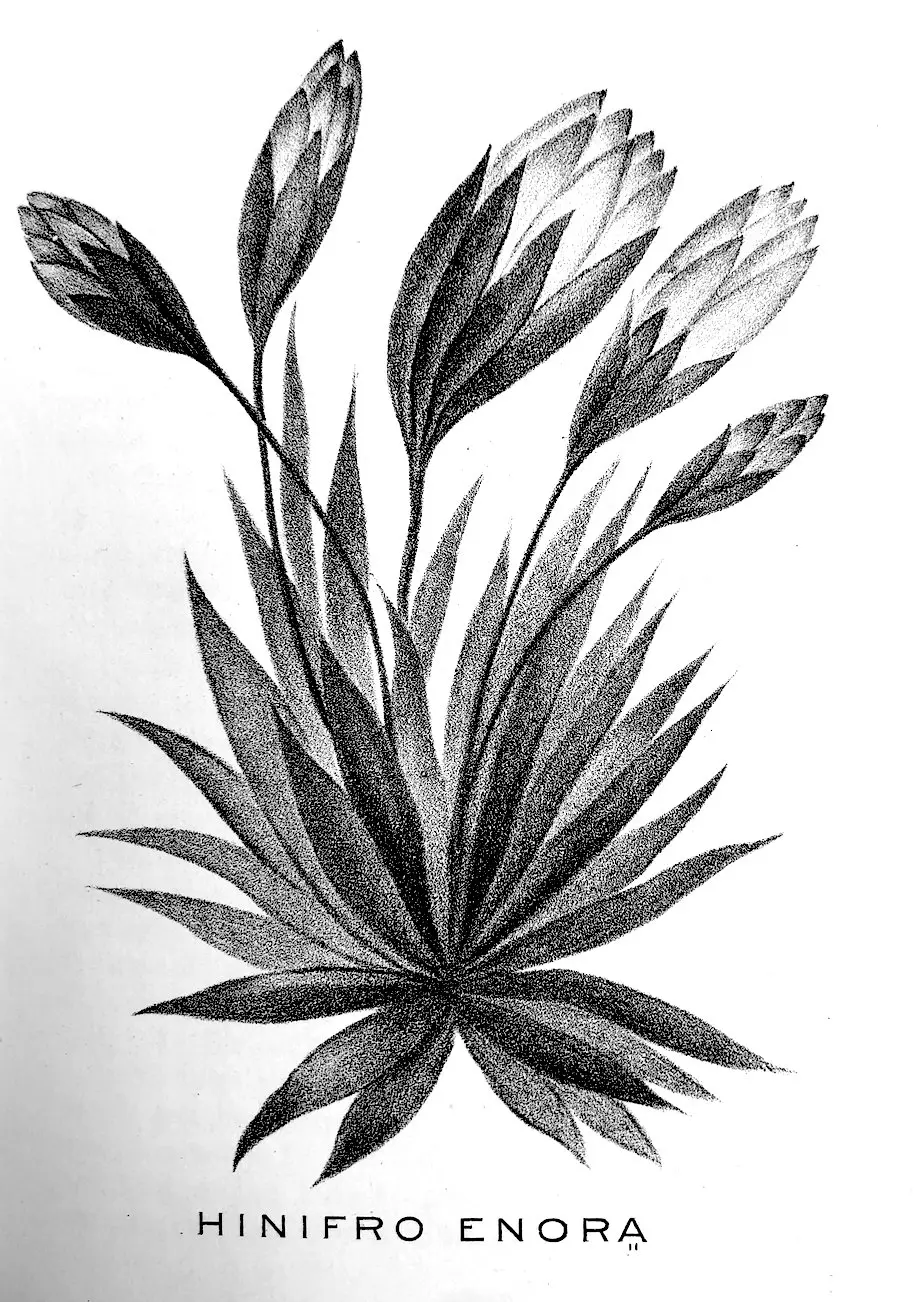
The Martians, who call their planet Ento, are at a crossroads: they are a superficially advanced people but are emotionally and scientifically stunted due to their belief that existence ends at death and that inquiring into the afterlife or other worlds is immoral. Sara Weiss, given the Entoan name Gentola̤, is tasked with psychically possessing prominent Martians and convincing them of the existence of life on Earth and after death.
The book is more than 500 pages long, with deeper worldbuilding than is typical of early science fiction. There’s a glossary of the Entoan language, illustrations (allegedly by Aaron Poole guiding Sara Weiss’s hand), and rich descriptions of Ento’s Bendolû-iffon Tylûsa̤a̤, iridescent cities in rainbow hues.
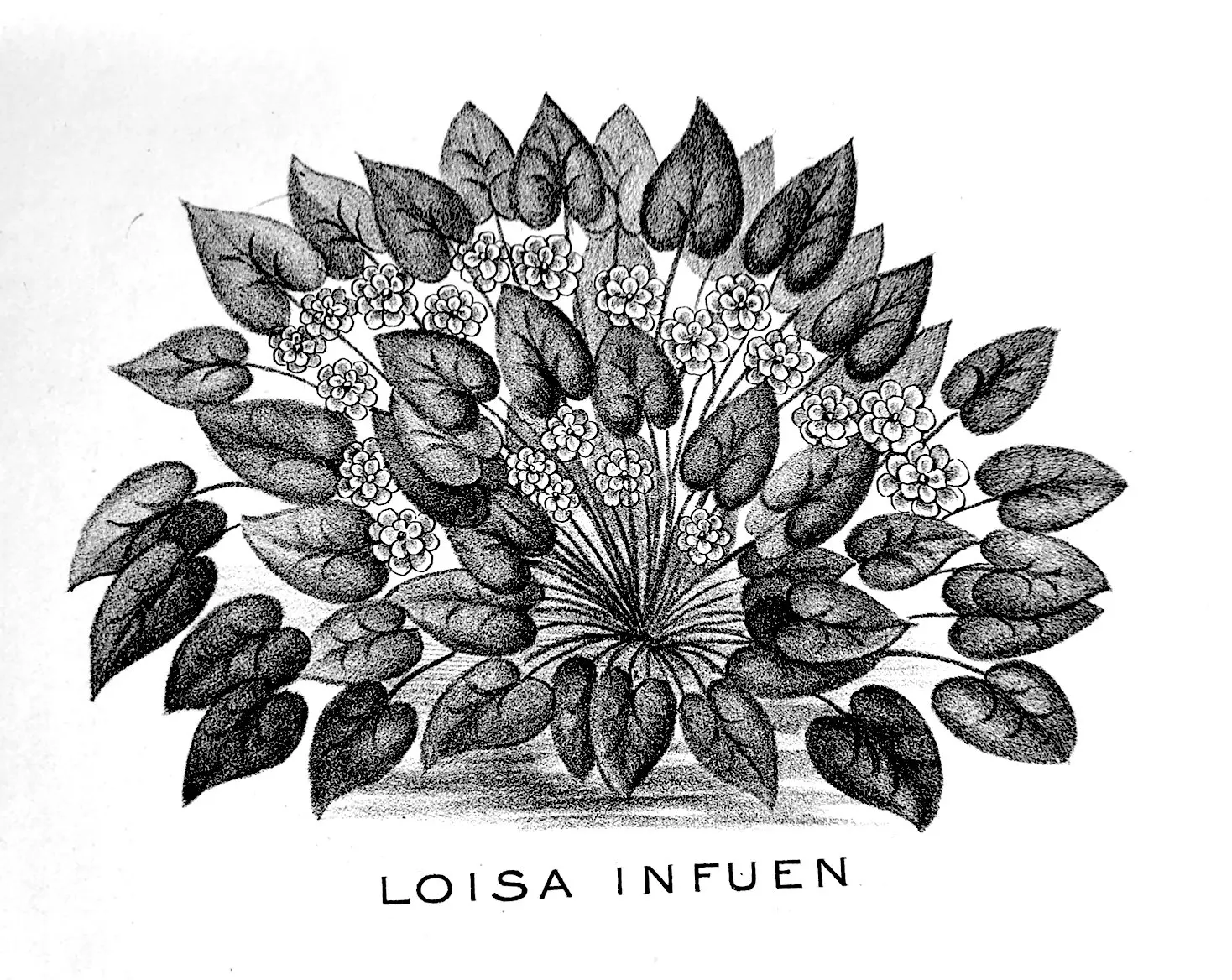
Each chapter describes a discrete psychic visitation and, like a play, contains only dialogue variously attributed to Weiss, her spirit guides, or the Entoans themselves. The spirit guides act as a kind of Greek chorus, narrating the events and verbally relaying the qualities of Martian architecture and biology. This narrative structure allows Weiss to observe Ento over periods of centuries, a unique conceit among utopian works of the period which otherwise tend to describe a perfect present with sparse historical detail about how the civilization evolved.
Most of the spirit guides are fictional, but several are meant to represent Sara’s own deceased family, including her siblings (one apparently stillborn) and a son Bernard who died as an adult. These passages are touching and yet hard for a modern reader to interpret. Are they wish fulfillment? Hallucinations experienced by the actual Sara Weiss? Is the book an elaborate novel with a backstory that her family resolutely stuck to?
I wasn’t able to confirm the existence of her spirit guide relatives in historical records, but neither was I able to find any evidence that Sara Weiss was anything but sincere in her beliefs that she communicated, more than once, with the “spirit side.”
Biography
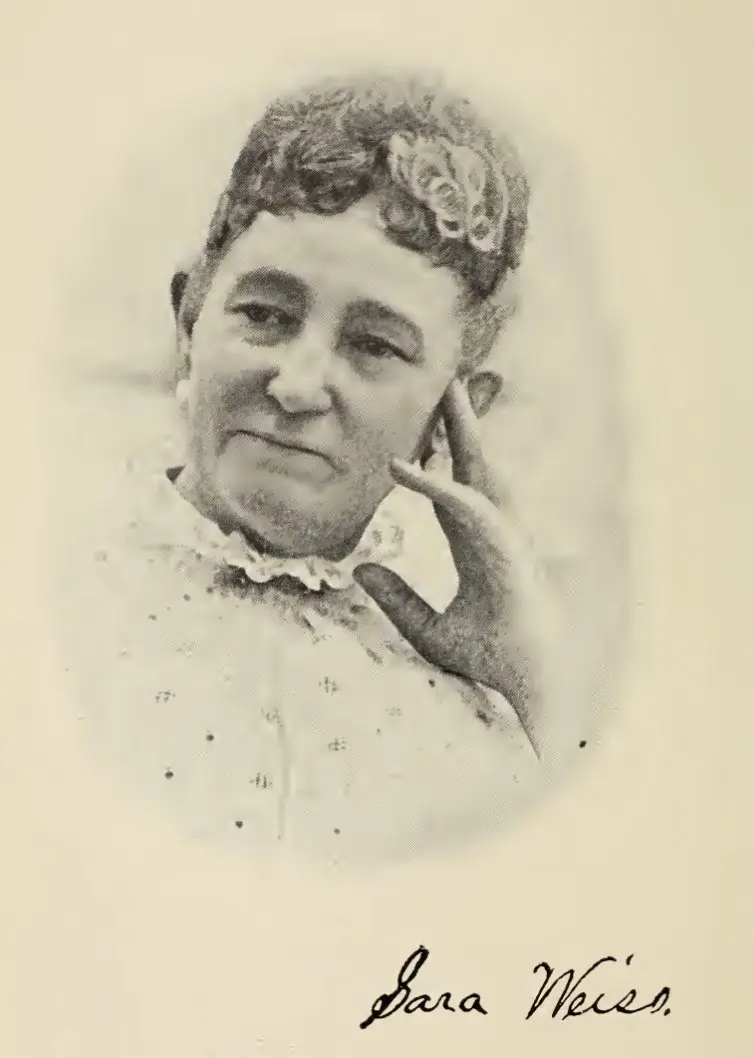
Sara Weiss was born Sarah Ditto McBride on January 5, 1832 in tiny Rushville, Ohio. Her father, a Scottish immigrant, was a farm laborer. Her upbringing was described later as “narrowly religious” with both parents preferring that women receive only a rudimentary education. In 1850, only 16 years old, she was married to the 44-year-old William Moeller (his second marriage, his first wife having died in childbirth). Together they had one surviving daughter, Adelaide, in 1855. Sara never mentioned Moeller in any of her writing.
After Moeller’s death, Sara and Adelaide relocated to St. Louis and in 1873 39-year-old Sara married 25-year-old Adolph M. Weiss, an Austrian immigrant and claims adjuster who worked for what would eventually become American Express. They likely met through Adelaide’s husband Chauncey Crosby, by then a rising executive at the firm.
“If you are not afraid, I won’t be.”
Sara Weiss first appeared in parapsychological literature in 1891, in a letter from William. A. Kelsoe to the British Proceedings of the Society for Psychical Research. Kelsoe was a respected St. Louis journalist but also a lifelong believer in psychic phenomena; he would eventually spin this initial report into a long and credulous interview with Weiss in the St. Louis Post-Dispatch.
According to her account, Weiss had been staying with her pregnant daughter in New York City. She dreamt that Adelaide went into early labor, and that Weiss was psychically infused with all the knowledge of an experienced midwife and successfully delivered the baby. After the birth, an unfamiliar doctor arrived, wearing “a blue satin necktie with a peculiar coral figure on it.” Weiss related this curious dream to her daughter and son-in-law.
Four days later, on January 25th 1881, Adelaide did go unexpectedly into labor, and due to excessive snowfall no doctor was reachable. Kelsoe quotes Weiss (edited for brevity):
“My daughter looked at me in terror and said, ”Oh what shall I do?” In a moment all sense of claim left me, and all sense of sympathy beyond what a very cool and experienced doctor might feel. I heard myself say in a peremptory fashion, “Ada, don’t be afraid, I know just what to do, all will go well.” She looked at me in a surprised way and replied: “If you are not afraid, I won’t be.” The nurse was panic-stricken and ran from the room. I went after her and in a manner foreign to me, directed her how to assist me—I do not deem it proper or necessary to go into details. Suffice it to say that I succeeded perfectly, although there were birth complications.”
When a doctor finally did arrive, Weiss noted that he looked familiar. “At this moment my daughter plucked my dress and whispered, ‘Look at the doctor’s cravat.’ In a moment I knew he was the man I saw in my dream. If my information was not from some foreseeing intelligence, where did it come from?”
Journalist Kelsoe dutifully interviewed family friends and Adelaide herself. All confirmed that the dream preceded the birth. The child’s birth date matches that of Adelaide’s first surviving son, Wilson Royal Crosby, about whom I will digress.
“Since my work has been complete I have done nothing with it”
A June 2, 1901 interview with Weiss appeared in the St. Louis Dispatch, uncredited but surely by William Kelsoe. It reproduces Weiss’s sketches of “Martian flowers”, some of which would appear in Journeys to the Planet Mars, meticulously captioning their original colors. At the time the manuscript had not yet been published—“They keep the pictures and the stories in their own home, unpublished, now a family treasure for seven years.”
In the interview, Sara traces her mediumship to a family friend named Will Cox who died of consumption in Texas. Three years after his death, Sara believed he had taken possession of her arm and forced her to write his name. (My assumption is that this person existed and probably worked for the express company, but there’s insufficient biographical detail to confirm.) Sara continues:
“Seven years ago I was an invalid. During my convalescence a band of people in the spirit world made me the medium through which they wrote and illustrated a work on the planet Mars and its flowers. I have always kept the manuscript and the pictures, but have never attempted to publish them. […]
“Aaron Poole always told me which color to use. When I made the rodel, the national flower of Mars, I was at a loss to know how to make a white flower. Aaron Poole showed me how it could be done with a black pencil on white paper. He died at Philadelphia 40 years ago, and had been by profession an artist. He made all the pictures of flowers through me.”
(An Aaron Poole did die in Philadelphia around this time, but he was a bricklayer.)
Publication and reception
In August of 1901 Sara Weiss travelled to New York “to superintend the publication of her book” (and probably to visit her daughter). The first edition was issued in 1903 and was reasonably well circulated to reviewers, with mixed outcomes.
In December 1903 the St. Louis Dispatch published an even longer and more lushly illustrated article on Weiss, less a book review than a thorough summary of the plot, presented entirely as fact:
It was not by man-flight or airship or Jules Verne projectile or the force of planetary attraction that Mrs. Weiss and her distinguished companions went from earth to Mars—it was by soul flight. Yet almost the first thing they saw when they got there was an airship rapid transit line, and Mrs. Weiss learned that the north and south poles of Mars had long ago given up their secrets to scientists who used airships for polar exploration.
The New York Times Book Review was less kind, deploying all the snark that 1903 had to offer:
As for what Sara Weiss and her obliging friends saw in their visits to Ento, you must read the book to learn. Wild horses could not draw from us the secrets of 528 of its 548 pages. There is a great deal of description, though, of a great many things; of cities and rivers and mountains, of gardens and palaces, of the products of the planet, animal, vegetable, and mineral. And it is all set down so lucidly and eloquently that is as easy to read as an aged almanac or a volume of Patent Office reports.
while the Boston Evening Transcript was more succinct: “It is about as interesting as a table of logarithms.”
Death and afterlife
Sara Weiss died at home on March 23, 1904, age 70, of stomach cancer, an illness which had been plaguing her for some time. She amended her will in February of that year, likely to append the clause specifically assigning rights to her illustrations, plates, and “manuscript not published” to her husband. (To her daughter she left all her “wearing apparel.”) She requested cremation and her remains rest with her husband and son-in-law.
A second edition of the book followed in 1905, this time published by The Austin Publishing Company, containing a much more exuberant title page.
Parapsychologist James Hyslop, an uncritical believer in mental mediumship, took an interest in Sara Weiss’s book and struck up a correspondance with her widower in 1912. Their letters, published in a 1913 article in the Journal of the American Society for Psychical Research is a rich source of first-person biographic detail about Sara, and reinforces the notion that none of it—Sara’s premonitions and dreams, her automatic writing and drawing—was any kind of put-on. Adolph Weiss, himself at the end of his life, seems completely sincere in his belief that his wife was a medium.
In the letters Hyslop is aggrieved that Sara’s original manuscript in pencil was not preserved—it was “all but illegible”— but Weiss supplies him with a sample of other automatic writing: a poem allegedly dictated by her deceased brother Robert. (Curiously, a Robert character appears briefly in the book, also accompanied by a poem, but is never otherwise identified.) The “Sorrowful Star” in the poem represents Earth, and the same term occurs in the book. Hyslop maintains that the handwriting was sufficiently different to convince him that the automatic writing was worthy of study, and quotes it in full to demonstrate that it is “a product above the usual automatic poetry which is so often inferior as to invite ridicule.”
“The Sorrowful Star”
Poem allegedly composed by Robert McBride, deceased, as communicated spiritually to his sister Sara Weiss:
Oh listen, my soul! A soft echo comes ringing
From the far away shores, from the homes of the blest,
And ever glad voices are singing, are singing.
“In the bright Spirit land there is rest; There is rest.”Hark! Again and again. The soft echo comes ringing
Adown toward the Earth, from the far spirit spheres.
From the homes where our loved ones are singing, are singing.
“As we sowed, we have reaped, in sorrow and tears.”Still again and again the sweet echo comes ringing;
It falls toward the Earth like the soft dropping rain.
And! the far away voices are singing, are singing.
“We garnered our sheaves in sorrow and pain.”Ah listen, the echo is ringing, still ringing.
I catch the faint sound as it falls from afar,
And still the sweet voices are singing, are singing.
“We have sowed. We have reaped, on the Sorrowful Star.”Now rising, now falling; the echo comes ringing.
“We have sowed. We have reaped, and we sorrow no more.
And ever glad anthems of joy are we singing,
In our beautiful homes, on the far shining shore.”I listen in silence. No echo comes ringing.
The voices of loved ones, I hear them no more.
But I know their glad voices are singing, are singing,
As they wave their dear hands, from the far shining shore.Oh listen, my soul! Is the echo still ringing?
Hear you not a faint note falling down from afar?
Ah no! ’Tis the wind that is sighing and singing.
And I am alone on the Sorrowful Star.
Examining the novel with at least a modicum of skepticism, Hyslop notes that Martian pronouns have suspiciously exact English correlates (including even thee and thou equivalents) and that the Martian number system is also base 10. “Of course this is not a fatal objection, but it awakens inquiry,” he writes, generous to fault, and adds that the subconscious might be subject to “coloring transcendental influences.”
Even though it’s ultimately fiction, I liked her vision of Mars, and the sweeping view of its evolution she describes. We read of its once-fertile heartland, crippled by climate change into a world-spanning desert, and the one Entoan family who digs its great canals to restore the waterways. We meet that couple, and their descendants, and their descendants, and witness their joy at reuniting across the generations and learning that death is not final and Ento is not alone in the universe.
I don’t believe she meant to deceive anyone. At the end of the book Sara writes:
An Air Transport is coming from toward the east, and—see, see, its passengers are throwing flowers down to the workmen and are calling, “Loha̤û, loha̤û, ēmanos.” [Hail, hail, friend.] What a strange, strange scene. I wish some of our Earth folk might witness it, for should I tell of it I fear that no one would credit my story.
And my copy of the first edition, the one published while she was still alive, is inscribed by her to a friend in a shaky hand: “God is truth perfectly manifested.”
Oriah, info oovistû, Sara Weiss. Thank you, until we meet again.
Adaptations
The ecology of the waterways of Mars, a 500-word interactive fiction piece purporting to be an excerpt from a reference work about Weiss’s Mars. Created for a game jam.
References and further exploration
Project Gutenberg HTML of Journeys to the Planet Mars, based on the first edition
“Pajamas from Spirit Land”, covering the Spirtualist movement and Hyslop’s larger role in it
Raw notes and bibliography for this piece with additional primary source material
